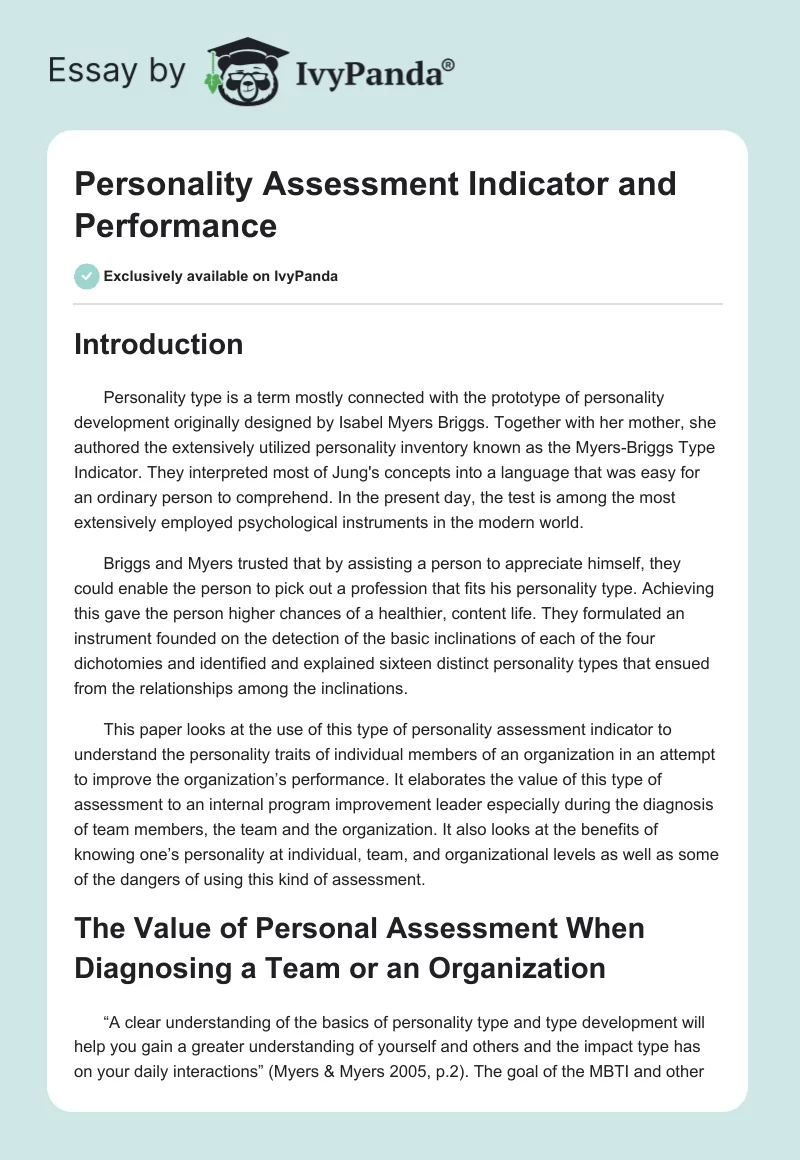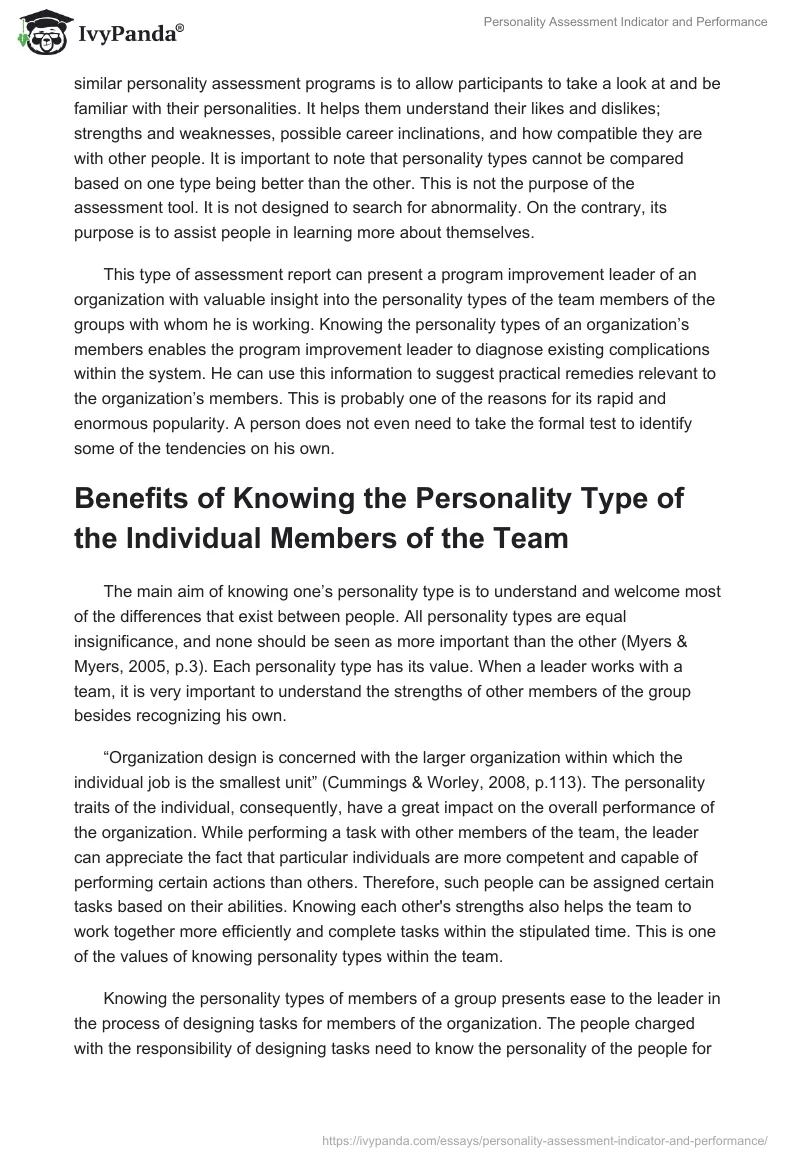Introduction
Personality type is a term mostly connected with the prototype of personality development originally designed by Isabel Myers Briggs. Together with her mother, she authored the extensively utilized personality inventory known as the Myers-Briggs Type Indicator. They interpreted most of Jung’s concepts into a language that was easy for an ordinary person to comprehend. In the present day, the test is among the most extensively employed psychological instruments in the modern world.
Briggs and Myers trusted that by assisting a person to appreciate himself, they could enable the person to pick out a profession that fits his personality type. Achieving this gave the person higher chances of a healthier, content life. They formulated an instrument founded on the detection of the basic inclinations of each of the four dichotomies and identified and explained sixteen distinct personality types that ensued from the relationships among the inclinations.
This paper looks at the use of this type of personality assessment indicator to understand the personality traits of individual members of an organization in an attempt to improve the organization’s performance. It elaborates the value of this type of assessment to an internal program improvement leader especially during the diagnosis of team members, the team and the organization. It also looks at the benefits of knowing one’s personality at individual, team, and organizational levels as well as some of the dangers of using this kind of assessment.
The Value of Personal Assessment When Diagnosing a Team or an Organization
“A clear understanding of the basics of personality type and type development will help you gain a greater understanding of yourself and others and the impact type has on your daily interactions” (Myers & Myers 2005, p.2). The goal of the MBTI and other similar personality assessment programs is to allow participants to take a look at and be familiar with their personalities. It helps them understand their likes and dislikes; strengths and weaknesses, possible career inclinations, and how compatible they are with other people. It is important to note that personality types cannot be compared based on one type being better than the other. This is not the purpose of the assessment tool. It is not designed to search for abnormality. On the contrary, its purpose is to assist people in learning more about themselves.
This type of assessment report can present a program improvement leader of an organization with valuable insight into the personality types of the team members of the groups with whom he is working. Knowing the personality types of an organization’s members enables the program improvement leader to diagnose existing complications within the system. He can use this information to suggest practical remedies relevant to the organization’s members. This is probably one of the reasons for its rapid and enormous popularity. A person does not even need to take the formal test to identify some of the tendencies on his own.
Benefits of Knowing the Personality Type of the Individual Members of the Team
The main aim of knowing one’s personality type is to understand and welcome most of the differences that exist between people. All personality types are equal insignificance, and none should be seen as more important than the other (Myers & Myers, 2005, p.3). Each personality type has its value. When a leader works with a team, it is very important to understand the strengths of other members of the group besides recognizing his own.
“Organization design is concerned with the larger organization within which the individual job is the smallest unit” (Cummings & Worley, 2008, p.113). The personality traits of the individual, consequently, have a great impact on the overall performance of the organization. While performing a task with other members of the team, the leader can appreciate the fact that particular individuals are more competent and capable of performing certain actions than others. Therefore, such people can be assigned certain tasks based on their abilities. Knowing each other’s strengths also helps the team to work together more efficiently and complete tasks within the stipulated time. This is one of the values of knowing personality types within the team.
Knowing the personality types of members of a group presents ease to the leader in the process of designing tasks for members of the organization. The people charged with the responsibility of designing tasks need to know the personality of the people for whom the tasks are designed. This information assists them in creating tasks relevant to the organization and its members.
Dangers of Using Personality Assessment Indicators to Label and Categorize Team Members
It is important to note that no answer is right or wrong in this assessment and that the purpose of the indicator is not to assess mental well-being or offer any kind of diagnosis on the mental competency or the participant. On the contrary, the basic aim of the instrument is to offer additional information about a person’s unique personality. However, this is not to say that this information cannot be abused or used in a way that can cause psychological harm to an individual.
Human resource staff who are acquainted with this kind of typology say that members of the organization typically respond positively to the test results if their type seems right to them. They then begin to see others differently if they know their personality types. Typologies are also likely to close the door on additional examination of personality dimensions since the instrument used appears complete in its descriptions.
The MBTI assumes that the four dimensions it measures are opposite dichotomies. It looks at traits like extraversion-introversion and sensing-intuition as distinct categories and uses a sorting process to place people in a separate category based on the direction they take from the mid-point. It does this without taking into account the scale of their scores. Like MBTI, most typologies impose an artificial separation on continuous scores that are distributed conventionally. Consequently, the outcome does not precisely display the exact characteristics of the fundamental attribute.
Precautions to Take When Using Personality Assessment Indicators in an Organization
There are considerable arguments in organizational psychology on the use of personality measures drive change in the organization with many people believing that the tests are not reliable and can be faked. Though personality tests have some predictive powers in assessing the potential of employees and team members, their reliability is not at a level that is high enough to be used to decide the fate of employees. The best we can say is that in certain situations, for certain purposes, certain personality measures can offer useful predictions. Therefore, the authority of any personality assessment must be determined precisely and expertly for the specific scenario in which it is to be used.
As more organizations embrace personality tests in an attempt to escalate their growth, cases of participants faking responses are not the only problems an organization should expect. If not properly designed, the possible legal complications of these tests can be immense and costly to the organization.
References
Cummings, T. G. & Worley, C. G. (2008). Organization development and change (9th ed.). Mason, OH: South-Western Cengage Learning.
Myers, P. B. & Myers, K. D. (2005). Myers-Briggs Type Indicator Interpretive Report. Web.


